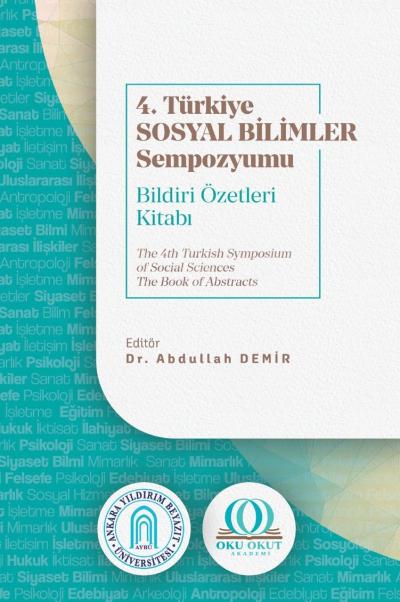Oku Okut Press reserves the right to publish and distribute the book. Permission from the publisher is required for any commercial use.
A Neglected Author in the Writing of The History Islamic Thought: An Analysis of Ḥaydar Āmulī’s Works in The Light of Bio-Bibliographic Data
İslam Düşünce Tarihi Yazımında İhmal Edilen Bir Müellif: Biyo-Bibliyografik Veriler Işığında Haydar Âmülî’nin Eserleri Üzerine Bir Tahlil
Authors
In this study, the works of Ḥaydar Āmulī, one of the significant Shi’ite scholars who lived in the 8th/14th century and came to the forefront with his Sūfī identity, will be evaluated in various contexts and will be subjected to evaluation in the history of Islamic thought. Āmulī was born in 719/1319-20 in Āmul, and went to cities such as Astarābād, Khurāsān, and Isfahān to study science, and took part in various political events in the Kinkhwariyya, the last branch of the Bāwandid dynasty. As a result of the spiritual crisis he experienced in 749/1348-49, he turned to Sūfīsm, and abandoned his duty as a vizier, with possessions, family, and friends behind, he went to the regions in Iraq that were considered sacred by the Shi’ites. Here, in the triangle of the cities of Baghdad, Hillah, and Najaf, on the one hand, he learned the basic principles of the Imāmiyya Shī’a by joining the circle of scholars belonging to the Hillah School, and on the other hand, he became affiliated with the Sūfīs belonging to the Akbarī tradition and read the fundamental texts of Sūfīsm with their commentaries. Thus, he had the opportunity to penetrate the teachings of the two schools, claimed that Sūfīsm and Shi’ism expressed the same truth from different perspectives, and wrote many works to substantiate this claim. In this context, he made references to the works he had previously written in his various books, especially in the list of works he included in the introduction of his commentary on Fuṣūṣ al-Ḥikām. Based on the information here, most of the works he authored can be identified in terms of name and content. It is possible to complete the works he did not cite in the books he wrote, both from the literature that emerged after him and from library records. This study, based on the sources mentioned, aims to discuss Āmulī's works in various contexts such as number, content, chronology, language and style, and method. Thus, it will be determined where the author, who came to the forefront with his project of combining the principles of Sūfīsm with the teachings of Shi’ism, is positioned in the history of Islamic thought in terms of both Sūfīsm and Shi’ism through the works he wrote.
* This study is taken from my doctoral thesis titled “Sūfīsm-Shi’ism Interaction: The Example of Ḥaydar Āmulī”, which is being prepared under the supervision of Assoc. Prof. Ercan Alkan.
Bu çalışmada 8./14. yüzyılda yaşayan ve sûfî kimliğiyle ön plana çıkan önemli Şiî bilginlerden biri olan Haydar Âmülî’nin eserleri, çeşitli bağlamlarda ele alınarak İslam düşünce tarihi özelinde değerlendirmeye tabi tutulacaktır. Âmülî, 719/1319-20 yılında Âmül’de dünyaya gelmiş, ilim tahsili için Esterâbâd, Horasan ve İsfahan gibi şehirlere gitmiş ve Bâvendîler’in son kolu olan Kînhâriyye’de çeşitli siyasî görevler üstlenmiştir. 749/1348-49 yılında yaşadığı mânevî kriz sonucu tasavvufa yönelmiş ve vezirlik görevini, sahip olduğu mal ve mülkü, aile ve dostlarını geride bırakarak Şiîlerce kutsal sayılan Irak’taki bölgelere gitmiştir. Burada Bağdat, Hille, Necef şehirleri üçgeninde bir yandan Hille Ekolü’ne mensup âlimlerin ders halkasına katılarak İmâmiyye Şîası’nın temel esaslarını öğrenmiş, diğer yandan Ekberî geleneğe mensup sûfîlere intisap ederek tasavvufun temel metinlerini şerhleriyle birlikte okumuştur. Böylece iki ekolün öğretilerine nüfuz etme imkânı bulmuş, tasavvuf ve Şiîliğin farklı açılardan aynı hakikati ifade ettiğini ileri sürmüş ve bu iddiasını temellendirmek için pek çok eser kaleme almıştır. Bu bağlamda Fusûsu’l-hikem’e yazdığı şerhin mukaddimesinde yer verdiği eserler listesi başta olmak üzere çeşitli kitaplarında daha önce kaleme aldığı eserlere atıf yapmıştır. Buradaki bilgilerden hareketle telif ettiği eserlerin çoğu, isim ve içerik olarak tespit edilebilir. Yazdığı kitaplarda atıf yapmadığı eserleri ise gerek kendisinden sonra oluşan literatürden gerekse kütüphane kayıtlarından tamamlamak mümkündür. Bu çalışmada bahsi geçen kaynaklar esas alınarak Âmülî’nin eserlerinin sayı, içerik, kronoloji, dil ve üslup, yöntem gibi çeşitli bağlamlarda ele alınması amaçlanmaktadır. Böylece tasavvufun esaslarını Şiîliğin öğretileriyle birleştirme projesiyle ön plana çıkan müellifin, kaleme aldığı eserlerle gerek tasavvuf gerekse Şiîlik açısından İslam düşünce tarihinde nerede konumlandığı tespit edilecektir.
* Bu çalışma Doç. Dr. Ercan Alkan danışmanlığında hazırlanmakta olan “Tasavvuf-Şiîlik Etkileşimi: Haydar Âmülî Örneği” başlıklı doktora tezi esas alınarak hazırlanmıştır.
Copyright
Copyright (c) 2024 Oku Okut Press
ePub License

This work is licensed under a Creative Commons Attribution-NonCommercial 4.0 International License.
A Neglected Author in the Writing of The History Islamic Thought: An Analysis of Ḥaydar Āmulī’s Works in The Light of Bio-Bibliographic Data
Downloads
Publication Information
-
Publication TypeChapter
-
Volume
-
Pages39-42
-
Published24 August 2024
-
Series
-
Series Position6
-
Categories
Baş, Emrah. “A Neglected Author in the Writing of The History Islamic Thought: An Analysis of Ḥaydar Āmulī’s Works in The Light of Bio-Bibliographic Data”. The 4th Turkish Symposium of Social Sciences: The Books of Abstracts. ed. Abdullah Demir - critical ed . 6/39-42. Social Sciences Proceedings. Ankara: Oku Okut Press, 2024. https://doi.org/10.55709/okuokutyayinlari.296












